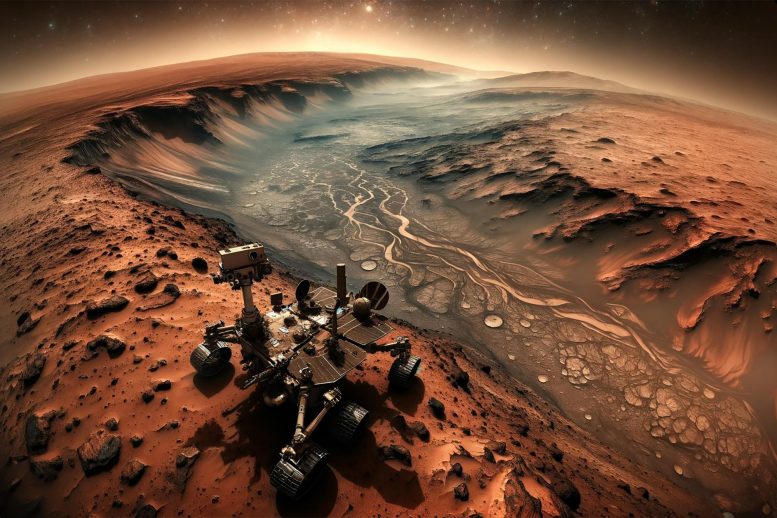NASA's Perseverance Rover Chronicles the Mysteries of Mars: A 360-Degree Exploration of Jezero Crater's Ancient River Delta
In the vast expanse of the Martian landscape, NASA's Perseverance rover continues its relentless pursuit of unraveling the Red Planet's mysteries. After 1,000 Martian days of exploration, the rover has brought forth a wealth of information about the ancient river delta history in Jezero Crater. In this comprehensive blog article, we will delve into the fascinating discoveries made by Perseverance, examining the geological wonders of Mars through a 360-degree panorama featuring 2.38 billion pixels.
Jezero Crater - A Window into Mars' Past
Jezero Crater is indeed a fascinating window into Mars' past, and I'm happy to share more details! Here's a deeper dive:
Geography and History:
Location: Jezero sits within the Isidis Planitia region, a massive ancient impact basin itself.
Formation: Formed roughly 3.8 billion years ago by a meteor impact, the crater is about 45 kilometers wide and 800 meters deep.
Past Environment: Evidence suggests it once held a deep lake fed by an ancient river system, with a delta deposited at the crater's edge. Minerals like clays and carbonates in the rocks support this.
Current Environment: Today, Jezero is a dry, desolate landscape with a thin atmosphere and extreme temperatures.
Scientific Significance:
Search for Past Life: Jezero's past lakebed and river sediments are considered prime targets for finding potential biosignatures, preserved remnants of ancient microbial life. This makes it a central focus of the Perseverance rover's mission.
Understanding Martian Climate: Studying the crater's geology and rock formations can tell us about the ancient Martian climate, its water cycle, and how it shifted from a warmer, wetter world to the cold, dry desert we see today.
Exploration Potential: Jezero provides a rich environment for future robotic and potentially even human missions to explore further, collect more samples, and deepen our understanding of the Red Planet's history.
Key Features:
Delta: The fan-shaped delta at the crater's edge holds layers of sediment deposited by the ancient river, potentially preserving biosignatures and clues about the water flow and lake's evolution.
Fan Delta Cliffs: Steep cliffs expose layers of delta sedimentary rock, allowing scientists to study them in detail.
Khartoum Plateau: A raised plateau within the crater contains clays and carbonates, suggesting ancient hydrothermal activity and potentially habitable environments.
Jezero Crater Floor: The crater floor might hold remnants of the lakebed, potentially containing further biosignatures or clues about the lake's chemistry and conditions.
Perseverance Rover's Role:
Exploration and Imaging: The rover is studying the delta, cliffs, and other features, taking images and collecting data on composition and structure.
Drilling and Sample Collection: Perseverance drills rock cores from different locations, collecting valuable samples for future analysis on Earth.
Astrobiology Investigations: The rover's instruments search for organic molecules and other potential biosignatures in the collected samples.
Future Work:
Sample Return Mission: NASA and international partners are developing a mission to retrieve the samples collected by Perseverance and other rovers, bringing them back to Earth for more advanced analysis in sophisticated laboratories.
Continued Exploration: Future missions could explore other Jezero features, search for deeper biosignatures, and potentially even drill into the crater floor to study the ancient lakebed directly.
Jezero Crater continues to be a thrilling target for Mars exploration, holding the potential to unlock secrets about the planet's past habitability and the possibility of past or even present life. It's truly a window into Mars' ancient past, shedding light on a time when the Red Planet may have been a very different world.
Overview of Jezero Crater as the chosen exploration site.
The significance of studying the ancient river delta and its potential to hold clues about past life on Mars.
Introduction to the Mastcam-Z instrument and its role in capturing the 360-degree panorama.
The Panoramic Marvel - Airey Hill Unveiled
Detailed analysis of the 360-degree mosaic composed of 993 individual images, totaling 2.38 billion pixels.
Exploration of the rover's location, referred to as "Airey Hill," with visible portions of the rover itself in the scene.
Explanation of the color enhancement applied to the image to simulate Earth-like lighting conditions, aiding scientists in interpreting the Martian landscape.
A Guided Tour by Perseverance's Project Scientist
Insightful commentary by Perseverance project scientist Ken Farley, offering a guided tour of the panorama.
Exploration of the geological features captured in the images, including rock layers, canyons, and riverbanks.
The importance of different rock layers in recording various stages of Jezero Crater's history.
Tracing the Ancient River's Path
Examination of the river that carved a canyon through the crater rim approximately 3.5 billion years ago.
Analysis of the sedimentary rocks deposited on the banks of the river, providing a historical record of the Martian environment.
Identification of boulders as evidence of a once-raging torrent and the potential for valuable information about the flow of water in Jezero.
The Lava Flow Mystery
Investigation of a peculiar outcrop that doesn't resemble sediment, raising the possibility of being a remnant of a lava flow.
Discussion on the potential for laboratory equipment on Earth to analyze volcanic rocks and determine the timing of water flow into Jezero.
Perseverance's Future Journey
Overview of Perseverance's planned route, heading west towards the river's carved crater wall.
Exciting prospects as the rover ascends a natural ramp leading out of the crater, marking a new phase of the mission.
Discussion of the rover's exploration of older rocks and the search for evidence of past life in a hydrothermal environment.
More : perseverances-360-degree-view-from-airey-hill
As Perseverance embarks on its mission to climb the delta and ascend the crater's rim, the journey promises even more revelations about Mars' ancient history. The rover's meticulous study of Jezero Crater and its surroundings opens new avenues for understanding the Red Planet's geological evolution and the potential for ancient life. Stay tuned for the next chapter in this captivating Martian odyssey!

Comments
Post a Comment